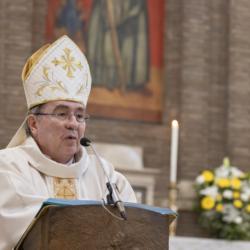Divorce Month
Jeff Bezos, the father of four and the richest man in the world, just announced that he and his wife of 25 years are divorcing. We learned from the same newspaper that January is not, as we had thought, the Return Christmas Gifts Month, but rather the Divorce Month. The newspaper carried a moving article by a divorced mother, describing her pain and the pain of her young daughters when her husband decided to bail on the family weeks before Christmas. His reason was he wanted to move in with his new girlfriend because her son was spending the holidays with his father -- her ex-husband -- and she might be lonely. Very compassionate.
This little domestic mess was made more poignant for the now father-absent family when they gathered to open presents. "When it came time to give me her gift, my seven-year-old was downcast, apologizing that she'd forgotten it at her father's new apartment. She'd bought it several weeks earlier with money from her piggy bank and said her father had promised to deliver it to her in time for Christmas."
This small family tale makes us want to do bodily harm to Dad, but it is hardly a singular example. The very nature of divorce is pain. Social scientists have done a good deal of research on the effects of divorce. They find divorce associated with increased occurrence of suicide, alcoholism, and depression. It is also associated with shortened longevity and all varieties of negative impacts on children, including a decline in school performance.
Concern about marital breakup has been a major American concern for several decades now. The PEW Research Center has been tracking marriage and divorce with increasing attention, but marriage is getting more difficult to study all the time. Getting a firm grasp of our mating and marriage problems is like trying to nail Jell-O to a wall. It keeps morphing into something else.
Most obvious, fewer and fewer Americans are getting married. Mating, yes, but not so many going to the church or town hall and formally tying the knot. A little less than 50 percent of Americans are currently married, and that figure varies depending on where people chose to live: 44 percent of city dwellers, 50 percent of suburbanites, and 51 percent of rural Americans. While those percentages are historically low, they would appear to keep the number of marital crack-up low, too. So, too, for the Millennials -- fewer are getting married. Ergo, fewer divorced. Family sufferings, similar to the Christmas story above, are minimized.
About 40 to 50 percent of married couples in the United States divorce, according to the American Psychological Association. The divorce rate among those who remarry is even higher.
The marriage picture is much more influenced by factors other than geography. What is called the Great American Divide is having a much bigger effect. That is the divide between the college educated, economically well-off and those with a high school education (or less) and a low-skill or no-skill job. In the era of the Beatles and the Vietnam War, what was called the upper class, in particular, and the middle class were the ones who were divorcing. Since then, the middle class has dramatically shrunk and the educated and economically well-off appear to be in much more stable marital relationships.
The new and growing class of those underemployed and often unskilled for today's economy is tending to shun marriages for cohabiting, often serial cohabiting. Where once that was a social stigma, today it is the expectation of a large segment of our nation. And, while this arrangement eliminates the legal niceties of divorce, the breakups are, nevertheless, filled with disappointment and suffering. This group is also a major source of the 35 percent of the country's children with no father at the dinner table. It is divorce in everything but name.
What's the marriage and divorce picture among Catholics? Confused. Primarily because so many of the faithful are not, well, faithful. Or as a witty friend of ours says, "they are on vacation" from the sacraments. Still, an estimated 28 percent of American Catholic adults who have ever been married have since divorced. That rate is lower than in the general public but still constitutes 11 million people.
When we were new at the marriage game, the mother of one of us, a happy and positive woman, sternly looked at us in the eyes and pronounced, "Divorce, never! Murder, maybe." (She read a lot of mysteries.) Mom knew that "marriage is hard" and that the love of newlyweds changes. She knew that it doesn't take long to get tired of the same stories and jokes, and jobs and children bring out anger and tensions never seen before the trip to the altar.
She also knew what most successful married couples know: you learn to be married. There is an old canard that a couples' most important sexual organ is the brain. That is true for the entire enterprise of marriage. We think our way to a good marriage or we don't. We can hurt or disappoint or isolate the other. The partner gradually becomes a barrier to what we want, a quiet enemy in residence. Walls go up. Real conversation stops. The thing dies.
But it doesn't have to. There are resources out there -- couples groups, books and retreats. There are marriage counselors. There are even some in your parish. And they're free! Plus, they have powerful arguments -- like saving our souls.
- Kevin and Marilyn Ryan, editors of "Why I'm Still a Catholic," worship at St. Lawrence Church in Brookline, Mass.



















